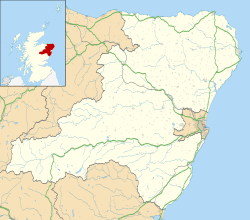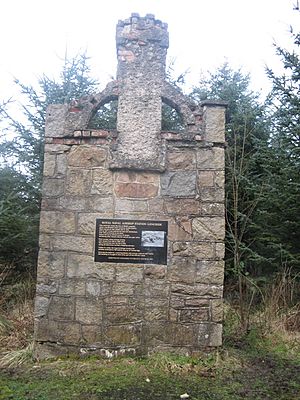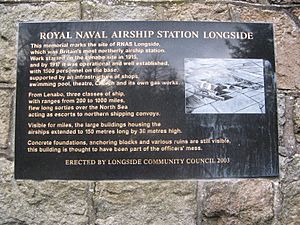RNAS Longside facts for kids
Quick facts for kids RNAS LongsideRNAS Lenabo RAF Longside |
|
|---|---|
| Longside, Aberdeenshire | |
| Coordinates | 57°28′26″N 1°57′00″W / 57.474°N 1.950°W |
| Type | Military – Airship station |
| Site information | |
| Owner | Air Department 1915–1918 Air Ministry 1918–1920 |
| Controlled by | Royal Naval Air Service |
| Open to the public |
Yes, as a woodland |
| Site history | |
| Built | 1915 |
| In use | 1916–1920. |
| Battles/wars | First World War |
RNAS Longside was a special airship base. It was used by the Royal Naval Air Service during the First World War. The base was located near Longside in Aberdeenshire, Scotland. It was built in 1915 and operated from 1916 until 1920. After the war, most of its large buildings were taken down.
People sometimes called it RNAS Lenabo. Locals even called the airships "Lenobo Soo". This name combined the area's name with a local word for a pig. It was the most northern airship base in mainland Britain. Airships from here patrolled the North Sea and the northeast coast. They helped protect ships during the war. Today, the site is a forest, and you can hardly tell it was once a busy airship station.
Contents
Building the Airship Base
The land where RNAS Longside was built was very wet. It was a large bog area called Lenabo. The name "Lenabo" comes from a Gaelic phrase meaning "wet meadow of the cows." This was a perfect description of the land. Before building could start, thousands of workers had to clear the site. These workers were from Ireland and Scotland. They removed a lot of peat from the 950-acre area. They used simple tools like steam scoops and bucket cranes.
What the Base Looked Like
The base had many large buildings. There were three huge airship sheds. These sheds were about 100 feet (30 meters) tall. You could see them from miles away because the land was flat. The base also had two tall chimneys, about 66 feet (20 meters) high. There were also places for storage, workshops, and offices. Soldiers lived in barracks on the site. Unlike many wartime buildings, these were made to last. They used heavy concrete and brick. The main entrance had two concrete pillars with fancy globes on top.
The biggest shed could hold four airships. The smaller hangars could hold one or two. About 1,500 people lived and worked at the base. They had many facilities, like a swimming pool, shops, a theatre, and a church. There was even a gas works on site.
Life at the Base
The base became active in 1916. This was when two deflated airships arrived by train. The base was like a small town. A magazine called "The Battlebag" was even made and shared there.
A special railway line ran from Longside to the base. The Great North of Scotland Railway operated it. This line was only for the air station. It started working in late 1916. Over 31,000 tons of coal were brought in by this railway. A local landowner was paid money for the railway using his land. He got his land back when the base closed. In 1920, a train on this line hit a car. This was the first fatal car accident in the Buchan area.
The huge doors of the airship hangars were very big. They ranged from 80 feet (24 meters) high and 113 feet (34 meters) wide to 105 feet (32 meters) high and 150 feet (46 meters) wide. These doors had rollers to make them easier to open. It is said that the famous Royal Air Force saying "Two six heave" started here. It was used by workers trying to open these massive doors.
Airship Operations
The commander of RNAS Longside was Lieutenant Commander Robinson. His second in command was Squadron Commander Moyes. The base used several types of airships. These included the NS class blimps like N.S.3, 4, 6, 11, and 12.
Challenges and Losses
Being an airship pilot was dangerous. In June 1918, an airship was damaged over the Firth of Forth. Five crew members were lost. The next month, another airship and its crew were lost in the North Sea. A wooden propeller from one of these airships was found. It is now kept in St John's Church in Longside. It serves as a memorial to the lost crew.
Strong winds caused problems for the airships. In September 1918, severe gales made it hard to land them. Four airships had to be "ripped" once they were safely inside the hangars. "Ripping" means pulling a cord to deflate parts of the airship on purpose. This was done to prevent damage in extreme weather. Airships like a C10A and an SSZ65 were among those ripped.
End of the Base
In 1919, during a coal strike, airmen from the base helped. They used their trucks to carry mail. As the war ended, there were 12 airships at the base. Locals continued to call the airships "Lenobo Soo." The base was quickly closed by the Air Ministry in 1920. Demolition companies bought it for a small amount of money. Most of the buildings were then taken down.
A Smaller Mooring Site
There was a smaller site near Montrose called Auldbar. This site was used to moor airships if bad weather prevented them from returning to the main Longside base. It was about 70 miles (113 km) south of Lenabo. It was the only mooring station in Scotland. Four areas were cleared in a forest to create "nests" for the airships. The trees helped protect them from the wind. Only a small staff was needed there. Today, not much is left of this site, just some traces of the mooring pits.
What the Site is Like Today
After the base closed in 1920, the area became a forest. When the trees were cut down in the 1960s and 1970s, some old buildings were found. The tall chimneys and entrance pillars were taken down in 1966. They were thought to be unsafe.
Today, the site is still a woodland. It is hard to see where the airfield used to be. But you can still find some concrete floors, mooring blocks, and other large pieces of concrete among the trees.
In 2003, the Longside Community Council placed a memorial plaque at the site. It is on a structure that might have been part of the officer's mess. This structure is near a small parking area at the forest entrance. The plaque has a photo of the base from the RAF Museum.
See also
- List of former Royal Air Force stations




